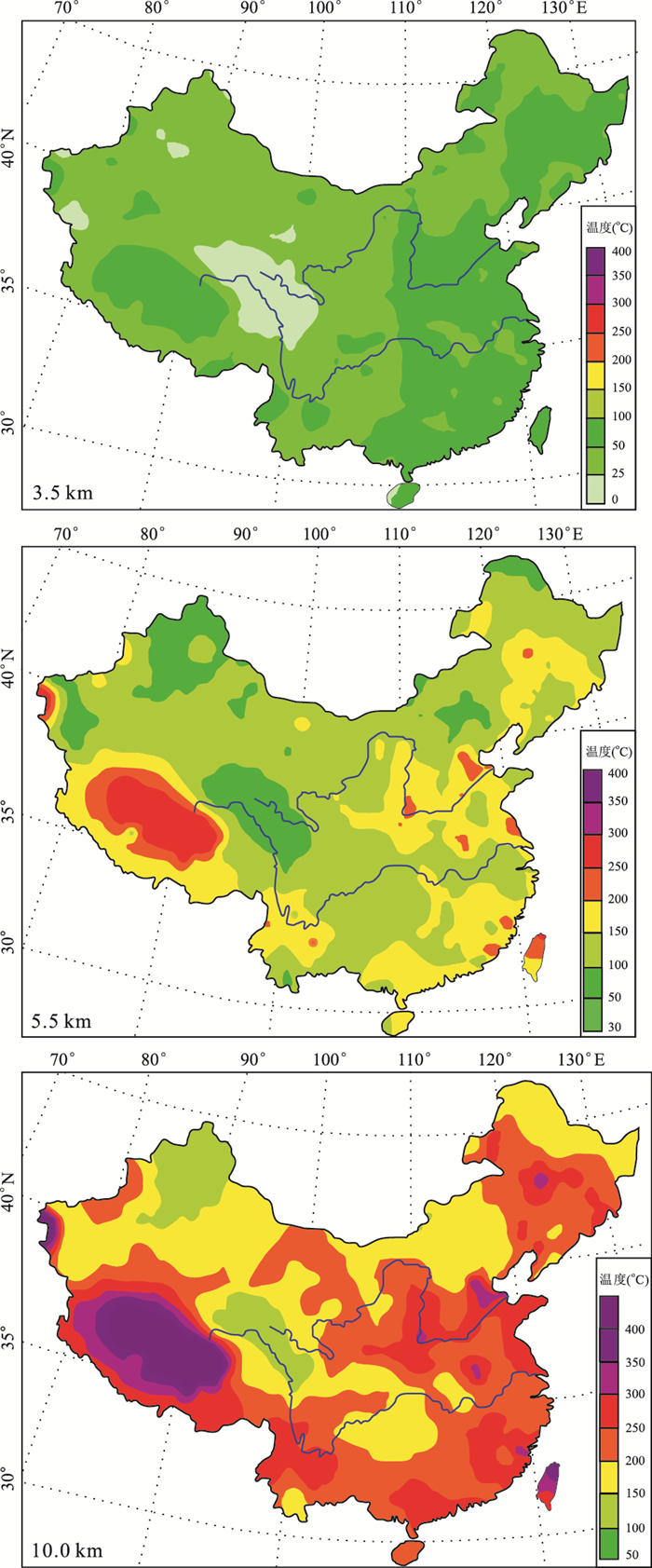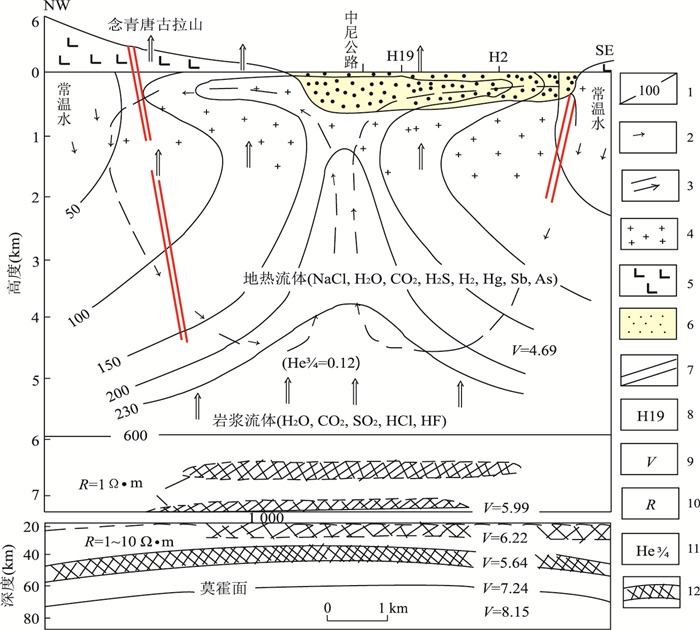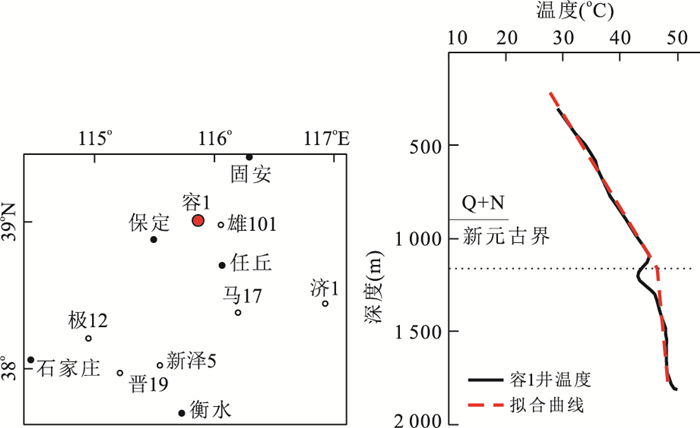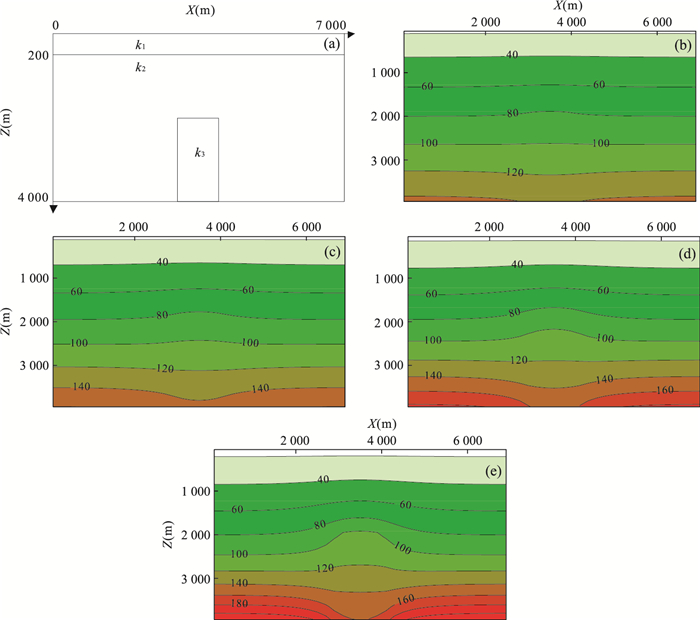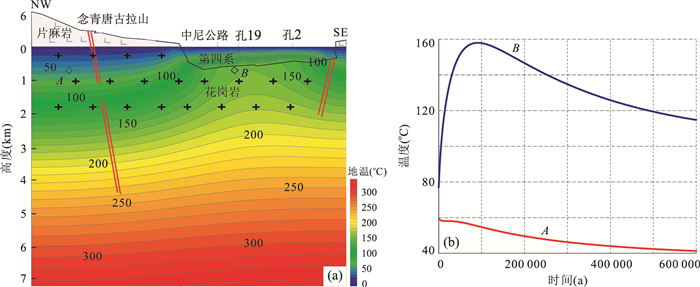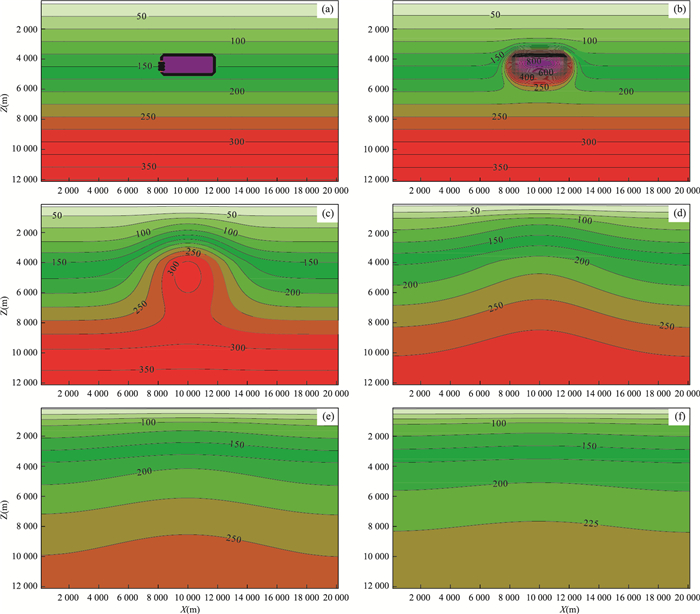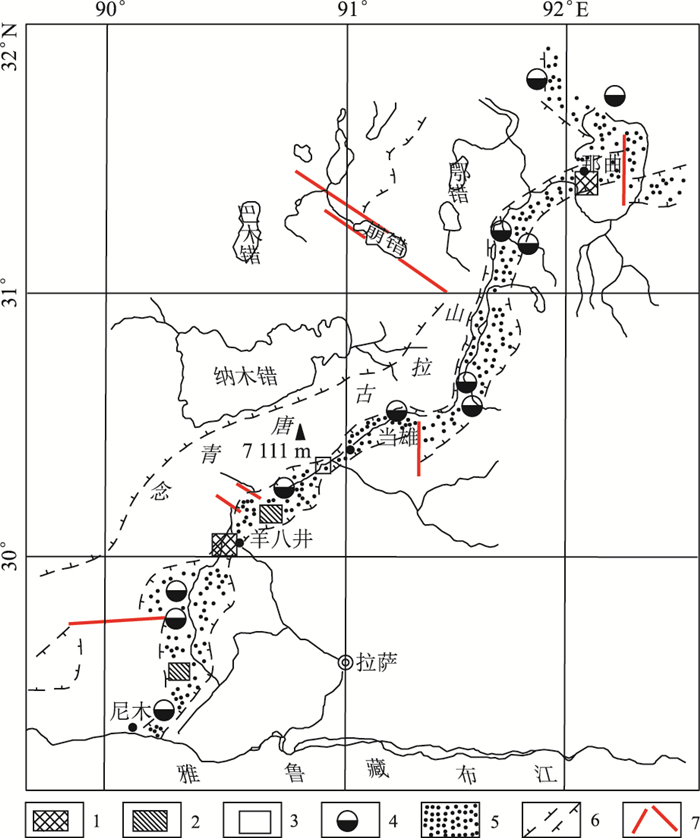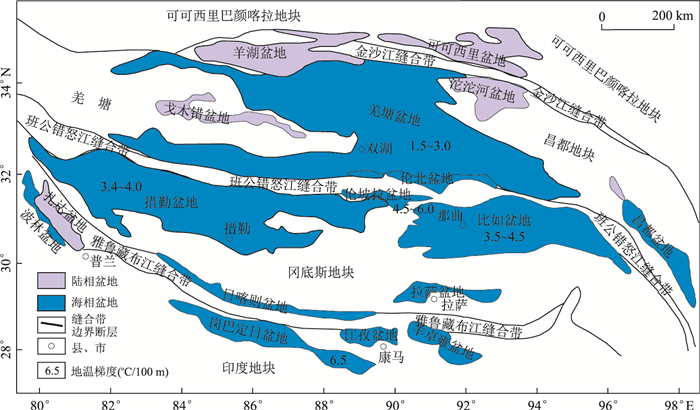Sources of Heat and Control Factors in Geothermal Field
-
摘要: 地热能越来越受到重视,但地热田的形成机制和热量的来源仍存在争议,多数学者认为岩浆囊可以为地热田直接供热.以二维热传导正演模拟为手段得出,盖层是形成地热田的必要条件;在浅部存在高热传导层时,地温剖面会出现镜像倒影形态,温度在垂向上分为高梯度段、低梯度段和低温段,侵位较浅(< 10 km)的岩浆囊散热和进入热平衡时间小于20~50万a.结合大量地热田温度资料分析认为,地热田的热量不是因为存在异常热源(如岩浆囊),而是来源于正常的基底热流.当深部热量传递到地表时,由于近地表物质的热传导能力的差异引起温度场发生变化,即地热田之下存在高热传导层快速地将基底热量传递到浅层而形成异常高温.Abstract: Geothermal energy is attracting increasing attention. However, the formation mechanism and the source of heat in geothermal fields are still in dispute. Most scholars believe that the magma pocket can provide direct heating for geothermal fields. In this paper, by means of 2D forward modeling of heat conduction, it is found that the caprock is a necessary condition for forming geothermal fields. When there is a high heat conduction layer in the shallow part, the geothermal profile will display a mirror reflection shape, and the temperature will be divided into high gradient section, low gradient section and low temperature section. The heat dissipation and thermal equilibrium time of the shallow magma pocket (< 10 km) are less than 200 000-500 000 years. Based on the analysis of the temperature data of a large number of geothermal fields, it is concluded that the heat in geothermal fields is from normal basal heat flow instead of the presence of abnormal heat sources, such as magma pocke. When the deep heat is transferred to surface, the temperature field changes due to the difference in the heat conduction ability of the near-surface material:the high heat conduction layer under the geothermal field will rapidly transfer the base heat to the shallow layer and form the abnormal high temperature.
-
Key words:
- temperature field /
- heat conduction /
- magma chamber /
- Yangbajing /
- Tengchong /
- geothermal gradient /
- environmental geology
-
图 2 中国陆区不同深度地温分布平面图
Fig. 2. Temperature distribution plan in different depths in mainland China
图 3 西藏羊八井盆地水热活动深部机制示意图
据姚足金(1986).1.等温线(℃);2.地热流体环流线;3.岩浆流体流向;4.花岗岩γ6;5.片麻岩;6.第四系松散堆积;7.主要断层;8.主要钻孔位置;9.纵波波速(km/s);10.磁大地电流(Ωm);11.气体氦;12.低速层、低阻体
Fig. 3. Schematic map showing deep mechanism of hydrothermal activity in Yangbajing basin
图 5 法国苏尔茨地区实测地温分布
Fig. 5. Measured gradient curve of ground temperature from Soults, France
图 10 青藏铁路沿线高温地热显示区分布
据胡先才(2010).1.发电为主的开发热田;2.已勘查评价热田;3.综合利用开发热田;4.有待进一步工作高温热田;5.第四纪沉积盆地;6.活动构造线;7.断裂
Fig. 10. Distribution of high temperature geothermal area along Qinghai-Tibet railway
图 11 伦坡拉盆地部分钻井测温-井深关系
Fig. 11. Relationship between temperature and depth in several wells in Lunpola basin
图 12 青藏高原构造分区和沉积盆地分布
Fig. 12. Distribution of Tectonic division and sedimentary basin in Qinghai-Tibet plateau
表 1 青藏高原地温梯度结果统计
Table 1. Results of geothermal gradient in Qinghai-Tibet plateau
序号 地区 地温梯度(℃/100 m) 1 羌塘盆地 2.73 2 羌塘盆地赤布张错多全区平均值 3 3 羌塘盆地拉雄错、董怀桑、隆鄂尼、野牛沟及安多及雀莫错等地区 1.5 4 北羌塘坳陷东部雀莫错剖面 2.7 5 措勤盆地 3.4~4.0 6 比如盆地 3.5~4.5 7 伦坡拉盆地 4.5~6.0 8 岗巴地区 6.5 9 藏南普莫雍湖 13~32 10 藏南羊卓雍湖 13~32 11 拉萨河谷 3.8 12 羊八井热田 1.9~5.9 13 拉多岗地热区 6.5~12.5 14 羊应乡热田 16~53 15 昌都盆地 5.0~6.0 16 松潘-阿坝地区 2.7 17 柴达木盆地 2.0~3.3 注:据陈红汉等(2013). -
Baria, R., Baumgärtner, J., Gérard, A., 1994.Status of the European Hot Dry Rock Geothermal Programmer.Geothermal Engineering, 19(1-2):33-48. Chen, H.H., Wu, Y., Xiao, Q.G., 2013.Thermal Regime and Paleogeothermal Gradient Evolution of Mesozoic-Cenozoic Sedimentary Basins in the Tibetan Plateau, China.Earth Science, 38(3):541-552 (in Chinese with English abstract). http://d.old.wanfangdata.com.cn/Periodical/dqkx201303011 Cheng, D.S., Li, Y.T., Lei, Z.Y., et al., 2000.Characteristics of Hydrocarbon Generation in Qiangtang Basin, Qinghai-Tibet Plateau.Scientia Geologica Sinica, 35(4):474-481 (in Chinese with English abstract). http://www.wanfangdata.com.cn/details/detail.do?_type=perio&id=dzkx200004011 Dong, S.W., Li, T.D., Chen, X.H., et al., 2012.Progress of Deep Exploration in Mainland China:A Review.Chinese Journal of Geophysics, 55(12):3884-3901 (in Chinese with English abstract). http://en.cnki.com.cn/Article_en/CJFDTOTAL-DQWX201212003.htm Fu, B.C., 1998.Cause of Geothermal Heat and Characteristics of Water Chemistry in Tengchong.Journal of Yunnan Polytechnic University, 14(3):46-50 (in Chinese with English abstract). http://www.wanfangdata.com.cn/details/detail.do?_type=perio&id=QK199800953280 Gao, J.L., Sun, C.Q., Zhang, L., et al., 2014.Scientific Drilling and Its Scientific Significance in Volcanic-Geothermal-Tectonic Belt in Tengchong, Yunnan.In: Chen, Y., ed., Joint Annual Meeting of the Earth Sciences of China, Beijing, 2748-2750 (in Chinese). Gong, Y.L., Wang, L.S., Liu, S.W., et al., 2003.Characteristics of Ground Heat Flow Distribution in Jiyang Depression.Science in China (Series D), 33(4):384-391 (in Chinese). Guo, Q.H., Liu, M.L., Li, J.X., 2017.Thioarsenic Species in the High-Temperature Hot Springs from the Rehai Geothermal Field (Tengchong) and Their Geochemical Geneses.Earth Science, 42(2):286-297 (in Chinese with English abstract). http://www.wanfangdata.com.cn/details/detail.do?_type=perio&id=dqkx201702009 Hu, X.C., 2010.Analysis on the Advantages of Geothermal Resources in Tibet.In: Wang, M., ed., Geothermal Energy in China: Achievements and Prospects-Symposium of 40 Anniversary Convention and Geothermal Development in China for Li Siguang Advocated the Development and Utilization of Geothermal Energy in China.Geological Publishing House, Beijing, 249-255 (in Chinese). He, L.F., Chen, L., Dorji, et al., 2016.Mapping the Geothermal System Using AMT and MT in the Mapamyum (QP) Field Lake Manasarovar, Southwestern Tibet.Energies, 9(10):855:1-13. doi: 10.3390/en9100855 Lang, X.J., Lin, W.J., Liu, Z.M., et al., 2016.Hydrochemical Characteristics of Geothermal Water in Guide Basin.Earth Science, 41(10):1723-1734 (in Chinese with English abstract). http://www.wanfangdata.com.cn/details/detail.do?_type=perio&id=dqkx201610008 Liu, Y.G., 2017.Preliminary construction of a Comprehensive Experimental Base for Deep Geothermal Resources Exploration and Development in Xianxian County, Hebei.China Geological Survey Results Bulletin, 21(3):1-2 (in Chinese with English abstract). Ma, G., Chang, E.X., Zhou, R.L., et al., 1983.A Preliminary Investigation on the Characteristics of a Geothermal Field and the Conditions for Its Formation in the Northern Part of the North China Plain.In: Chinese Academy of Geological Sciences, ed., Bulletin of the 562 Comprehensive Geological Brigade (4).Geological Publishing House, Beijing, 109-126 (in Chinese). Qiu, N.S., 2002.Characters of Thermal Conductivity and Radiogenic Heat Production Rate in Basins of Northwest China.Chinese Journal of Geology, 37(2):196-206 (in Chinese with English abstract). http://www.wanfangdata.com.cn/details/detail.do?_type=perio&id=dzkx200202007 Ren, Z.L., Zhang, S., Gao, S.L., et al., 2007.Tectonic and Thermal Evolution History of Ordos Basin and Its Metallogenic Significance.Science in China (Series D), 37(Suppl.1):23-32 (in Chinese). Shen, X.J., Wang, Z.R., 1984.Thermal Reservoir Model Analysis of the Yangbajing Geothermal Field, Xizang (Tibet) Autonomous Region.Science in China (Series B), 14(10):941-949 (in Chinese). http://kns.cnki.net/KCMS/detail/detail.aspx?filename=JBXG198412010&dbname=CJFD&dbcode=CJFQ Wang, J.Y., Hu, S.B., Pang, Z.H., et al., 2012.Estimate of Geothermal Resources Potential for Hot Dry Rock in the Continental Area of China.Science and Technology Review, 30(32):25-31 (in Chinese with English abstract). http://www.wanfangdata.com.cn/details/detail.do?_type=perio&id=kjdb201232007 Wang, S.B., Fu, J.L., Li, C.Z., et al., 2015.Preliminary Division for Neotectonic Episode of Tengchong Block, Southwest Yunnan.Geological Bulletin of China, 34(1):147-154 (in Chinese with English abstract). http://www.wanfangdata.com.cn/details/detail.do?_type=perio&id=zgqydz201501012 Wu, Z.H., Jiang, W., Zhou, J.R., et al., 2001.Thermal-Chronological Dating on the Thermal History of Plutons and Tectonic-Landform Evolution of the Central Tibetan Plateau.Acta Geologica Sinica, 75(4):468-476 (in Chinese with English abstract). http://www.wanfangdata.com.cn/details/detail.do?_type=perio&id=dizhixb200104006 Xiao, L., Li, X.Z., Hu, Z.H., et al., 2009.The Influences of the Soil Structure on the Calculation Model of Thermal Conductivity.Geological Review, 55(4):598-605 (in Chinese with English abstract). http://en.cnki.com.cn/Article_en/CJFDTOTAL-DZLP200904015.htm Yan, D.S., Yu, Y.T., 2000.Evaluation and Utilization of Geothermal Resources in Oil and Gas Area of Beijing, Tianjin and Hebei.China University of Geosciences Press, Wuhan, 20-30 (in Chinese). Yao, Z.J., 1986.An Assessment of Geothermal Resources in Yangbajing, Xizang (Tibet).In: Chinese Academy of Geological Sciences, ed., Journal of Institute of Hydrogeology and Engineering Geology (2).Geological Publishing House, Beijing, 12 (in Chinese). Yuan, C.P., Xu, S.H., 2000.Characteristics of Geotemperature Field and Maturity History of Source Rocks in Lunpola Basin, Xizang (Tibet).Experimental Petroleum Geology, 22(2):156-160 (in Chinese with English abstract). http://www.wanfangdata.com.cn/details/detail.do?_type=perio&id=sysydz200002012 Zhang, R.L., Yu, X., Yao, S.C., et al., 2015.Application Study on Audio-Frequency Magnetotelluric Method in Azelik Uranium Metallogenic Zone of Niger.World Nuclear Geoscience, 32(1):24-28 (in Chinese with English abstract). http://www.wanfangdata.com.cn/details/detail.do?_type=perio&id=sjhdzkx201501005 陈红汉, 吴悠, 肖秋苟, 2013.青藏高原中-新生代沉积盆地热体制与古地温梯度演化.地球科学, 38(3):541-552. http://earth-science.net/WebPage/Article.aspx?id=2722 程顶胜, 李永铁, 雷振宇, 等, 2000.青藏高原羌塘盆地油气生成特征.地质科学, 35(4):474-481. doi: 10.3321/j.issn:0563-5020.2000.04.011 董树文, 李廷栋, 陈宣华, 等, 2012.我国深部探测技术与实验研究进展综述.地球物理学报, 55(12):3884-3901. doi: 10.6038/j.issn.0001-5733.2012.12.002 符必昌, 1998.云南腾冲地热成因及水化学特征.云南工业大学学报, 14(3):46-50. http://www.wanfangdata.com.cn/details/detail.do?_type=perio&id=QK199800953280 高金亮, 孙春青, 张磊, 等, 2014.云南腾冲火山-地热-构造带科学钻孔概况及其科学意义.见: 陈颙, 编, 中国地球科学联合学术年会文集, 2748-2750. 龚育龄, 王良书, 刘绍文, 等, 2003.济阳坳陷大地热流分布特征.中国科学(D辑), 33(4):384-391. http://d.old.wanfangdata.com.cn/Periodical/zgkx-cd200304011 郭清海, 刘明亮, 李洁祥, 2017.腾冲热海地热田高温热泉中的硫代砷化物及其地球化学成因.地球科学, 42(2):286-297. doi: 10.3969/j.issn.1672-6561.2017.02.013 胡先才, 2010.西藏地热资源的优势分析.见: 汪明, 编, 中国地热能: 成就与展望——李四光倡导中国地热能开发利用40周年纪念大会暨中国地热发展研讨会论文集.北京: 地质出版社, 249-255. 郎旭娟, 蔺文静, 刘志明, 等, 2016.贵德盆地地下热水水文地球化学特征.地球科学, 41(10):1723-1734. http://earth-science.net/WebPage/Article.aspx?id=3374 刘彦广, 2017.河北献县深部地热资源勘查开发综合试验基地初步建成.中国地质调查成果快讯, 21(3):1-2. http://www.cqvip.com/QK/98197X/201801/674424136.html 马刚, 常恩祥, 周瑞良, 等, 1983.华北平原北部地温场特征及其形成条件的初步探讨.见: 中国地质科学院编, 562综合大队集刊(第4号).北京: 地质出版社, 109-126. 邱楠生, 2002.中国西北部盆地岩石热导率和生热率特征.地质科学, 37(2):196-206. doi: 10.3321/j.issn:0563-5020.2002.02.007 任战利, 张盛, 高胜利, 等, 2007.鄂尔多斯盆地构造热演化史及其成藏成矿意义.中国科学(D辑:地球科学), 37(S1):23-32. http://www.wanfangdata.com.cn/details/detail.do?_type=perio&id=QK200702216387 沈显杰, 王自瑞, 1984.西藏羊八井热田的热储模式分析.中国科学(B辑), 14(10):941-949. http://www.wanfangdata.com.cn/details/detail.do?_type=perio&id=QK000001579719 汪集旸, 胡圣标, 庞忠和, 等, 2012.中国大陆干热岩地热资源潜力评估.科技导报, 30(32):25-31. doi: 10.3981/j.issn.1000-7857.2012.32.002 王书兵, 傅建利, 李朝柱, 等, 2015.滇西南腾冲地块新构造运动阶段初步划分.地质通报, 34(1):146-154. doi: 10.3969/j.issn.1671-2552.2015.01.012 吴珍汉, 江万, 周继荣, 等, 2001.青藏高原腹地典型岩体热历史与构造-地貌演化过程的热年代学分析.地质学报, 75(4):468-476. doi: 10.3321/j.issn:0001-5717.2001.04.006 肖琳, 李晓昭, 胡增辉, 等, 2009.土体内在结构对热导率计算模型的影响研究.地质论评, 55(4):598-605. doi: 10.3321/j.issn:0371-5736.2009.04.014 阎敦实, 于英太, 2000.京津冀油气区地热资源评价与利用.武汉:中国地质大学出版社, 20-30. 姚足金, 1986.西藏羊八井地热资源评价.见: 中国地质科学院编, 水文地质工程地质研究所所刊(第2号).北京: 地质出版社, 12. 袁彩萍, 徐思煌, 2000.西藏伦坡拉盆地地温场特征及烃源岩热演化史.石油实验地质, 22(2):156-160. doi: 10.3969/j.issn.1001-6112.2000.02.012 张濡亮, 喻翔, 腰善丛, 等, 2015.音频大地电磁测深法在尼日尔阿泽里克铀成矿区的应用研究.世界核地质科学, 32(1):24-28. doi: 10.3969/j.issn.1672-0636.2015.01.005 -









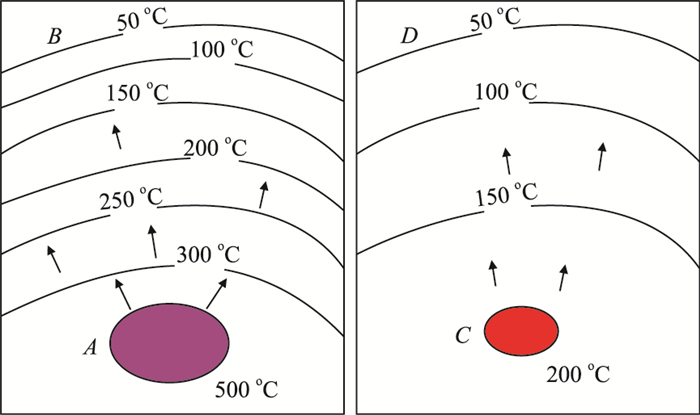
 下载:
下载:
